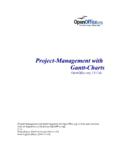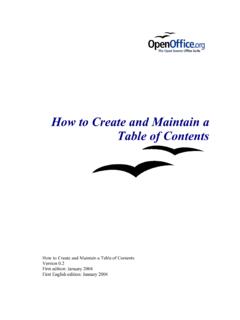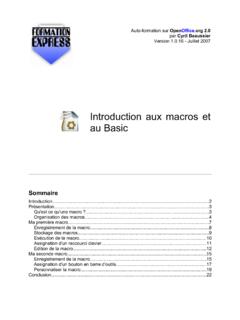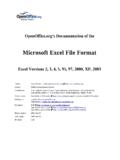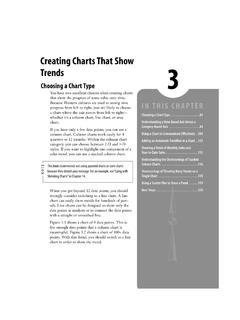Transcription of Inserting Spreadsheets, Charts, and Other Objects
1 Impress Guide Chapter 7. Inserting spreadsheets , Charts, and Other Objects Copyright This document is Copyright 2007 2009 by its contributors as listed in the section titled Authors. You may distribute it and/or modify it under the terms of either the GNU General Public License, version 3 or later, or the Creative Commons Attribution License, version or later. All trademarks within this guide belong to their legitimate owners. Authors Peter Hillier-Brook Jean Hollis Weber Michele Zarri Feedback Please direct any comments or suggestions about this document to: Publication date and software version Published 10 January 2009.
2 Based on You can download an editable version of this document from Contents Using spreadsheets in Inserting a Resizing and moving a Moving around the How a spreadsheet is Moving the cursor to a Entering Formatting spreadsheet Inserting a Creating a chart in Creating a chart using the Insert chart Choosing a chart chart Entering chart Opening a chart data Entering Formatting the Adding or removing elements from a Using the Format Resizing and moving the Moving chart Changing the chart area Changing the chart graphic Inserting Other Movies and OLE Other OLE Inserting the contents of a Inserting spreadsheets , Charts, and Other Objects 3.
3 Using spreadsheets in Impress A spreadsheet embedded in Impress includes most of the functionality of a spreadsheet in Calc and is therefore capable of performing complex calculations and data analysis. However, if you need to analyze your data or apply formulas, these operations are best performed in a Calc spreadsheet and the results displayed in an embedded Impress spreadsheet. Many people also use spreadsheets in Impress for creating complex tables or presenting data in a tabular format. However, for this purpose you may find the new Table Design feature (described in Chapter 3) more suitable.
4 Inserting a spreadsheet To add a spreadsheet to a slide, select the corresponding layout in the list of predefined layouts in the Tasks pane, as shown in Figure 1. Figure 1: The spreadsheet layout in the Tasks pane This inserts a placeholder for a spreadsheet in the center of a slide, as shown in Figure 2. Double-click inside the frame to enter the edit mode, shown in Figure 3, where you can insert data and modify the formatting of the spreadsheet. See Entering data on page 8 and Formatting spreadsheet cells on page 8. It is also possible to insert a spreadsheet as an OLE object as described in Inserting Other Objects on page 21.
5 4 Inserting spreadsheets , Charts, and Other Objects Figure 2: A slide ready to host a spreadsheet Figure 3: A spreadsheet in edit mode. Note the active cell and the smalle black resizing handles on the gray border When editing a spreadsheet, some of the contents of the main menu bar change, as does the Formatting toolbar (see Figure 4), to show entries and tools that support working with the spreadsheet. Using spreadsheets in Impress 5. Figure 4: The menu bar and the formatting toolbar in spreadsheet editing mode One of the most important changes is the presence of the Formula toolbar, just below the Formatting toolbar.
6 The Formula toolbar contains (from left to right): The active cell reference or the name of the selected range The Formula Wizard button The Sum and Formula buttons or the Cancel and Accept buttons (depending on the contents of the cell). A long edit box to enter or review the contents of a cell If you are familiar with Calc, you will immediately recognize the tools and the menu items since they are much the same. Resizing and moving a spreadsheet When resizing or moving a spreadsheet, ignore the first row and the first column (easily recognizable because of their light gray background) and the horizontal and vertical scroll bars).
7 They are only used for editing purposes and will not be included in the visible area of the spreadsheet on the slide. To resize the area occupied by the spreadsheet: 1) Double-click to enter the edit mode, if it is not already active. Notice the black handles found in the gray border surrounding the spreadsheet (see Figure 3). 2) Move the mouse over one of the handles. The cursor changes shape to give a visual representation of the effects applied to the area. 3) Click and hold the left mouse button and drag the handle. The corner handles resize the two sides forming the corner simultaneously, while the handles in the middle of the sides modify one dimension at a time.
8 6 Inserting spreadsheets , Charts, and Other Objects You can move the spreadsheet (change its position within the slide). whether in edit mode or not. In both cases: 1) Move the mouse over the border until the cursor changes shape. 2) Click and hold the left mouse button and drag the spreadsheet to the desired position. 3) Release the mouse button. When selected but not in edit mode (green handles), the spreadsheet object is treated like any Other object, therefore resizing it results in changing the scale rather than the spreadsheet area. This is not recommended, because it may distort the fonts and picture shapes.
9 Moving around the spreadsheet How a spreadsheet is organized A spreadsheet consists normally of multiple tables which in turn contain cells. However, in Impress only one of these tables can be shown at any given time on a slide. The default for a spreadsheet embedded in Impress is one single table called Sheet 1. The name of the table is shown at the bottom of the spreadsheet area (see Figure 3). If required, you can add Other sheets. To do that: 1) Right-click on the bottom area near the existing tab. 2) Select Insert > Sheet from the pop-up menu. Just like in Calc, you can rename a sheet or move it to a different position using the same pop-up menu or the Insert menu on the main menu bar.
10 Even if you have many sheets in your embedded spreadsheet, Note only one sheet the one which is active when leaving the spreadsheet edit mode is shown on the slide. Each of the sheets is further organized into cells. Cells are the elementary unit of the spreadsheet. They are identified by a row number (shown on the left hand side on gray background) and a column letter (shown in the upper part again on gray background). For example, the top left cell is identified as A1, while the third cell in the second row is C2. All data, whether text or numbers, is input in a cell.
